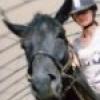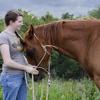Cherish's Xrays for Morgan (and anyone else) to critique !
Forums
Re: Cherish's Xrays for Morgan (and anyone else) to critique !
[quote="CMhorses"][quote="Sara"]Oh, fantastic visuals! I saved that for future reference. Is that the way you would trim any horse that had been allowed to get very long?[/quote]
I always thought it was better to trim them gradually over a few days or weeks,but I'm not an expert.[/quote]
Not in a case like this. Vertical shortening in a hurry never hurt any horse if you shorten them just to the lenght they should be (all they do is get a bit shorter ^^ I make ponies!! lol) and getting the flared toe taken care of fixes breakover, relieving a lot of strain and setting everything to grow correctly. It was nothing but in the way. The gradual thing is for more tricky problems like correcting angles (such as a bullnosed hind hoof, you can only go so far into the toe in one trim, you have to trim and trim and trim over time to get them shortened and everything back in shape) I rarely muck with angles, And when I do it's a matter of like 2 degrees at a time lol. Unless it was something just stupid like one overgrown horse was in a pasture and on one foot a chunk of toe had broken off and on the other the heel has smashed, that was a case of "duh, his hooves arent exactly [i]suposed[/i] to be 10 degrees different" ;)
The other thing I'll take my time on is concavity. especially a horse just coming out of shoes. removing the shoe is going to restore a certain amount of flexibility to the hoof which can feel pretty wierd to the horse, if you increase that by triming the concavity out imediatly they can go downright lame. Huge overgrowth can have about that same effect as a shoe in that respect so I'm carefull after a large set up trim as well.
As for would I trim any horse that goes long this way? pretty much. Shorten vertically first, then take care of flares (note that this kind of rolling can be applied to a flare off the side of the hoof as well, just harder to quantify and must be done more by visual aproximation and just feeling it out, once you get the hange of the toe flares its a piece of cake)
If it's just a little flare from going a few weeks too long between trims I wont even bring out a measuring tape, just roll it . I'll think I have a picture of this on my other computer....
most horses that get long will flare forward like that, occasionally if they are very hard and dry they will only flare below that vertical shortening cut and you can really impress people with your one trim wonder fix :P
[quote]Morgan, how do you know you won't be cutting into the white line like that?[/quote]
Sometimes you will :shock: The white line can grow foreward just like the hoof wall, and there can come a point when it it just part of the junk that is in the way. If you've ever seen a extreme slipper foot some of them have wall, white line (or wedge) and sole that grow extremely far foreward and up. The only way to get the horse moving is to get the junk off from in front. Now if you trim into white line on a healthy (straight walled) hoof I WOULD be worried. just stay outside of that radius.
[quote]On some horses that is a HUGE amount to trim off and I'd be very nervous about getting to close when cutting blind like that.[/quote]
Yes on some horses it is but if it's [i]excess[/i] why leave it?
And it's not at all blind.Tthe key to the whole thing is getting the initial vertical shortening and measurement right. If you can learn that you're plenty safe with the rest of it.
For the shortening you read the sole and the concavity. You want to find what length the toe would be were it still attached. For example: if the sole is fairly normal you flake off the dead stuff, trim the wall down to it and measure. But if the hoof is very deformed and there is NO depth under PIII (penetration or nearly so) you would trim the wall that's holding the hoof up only down to aproximatly where it would be if there were a good sole, provided there is any suporting wall at all. If there is not and the bone is practically on the ground, you measure then add an amount aproximating a healthy sole, to give you the natural length, that is then the measurement you use to continue to the toe rolling.
Once you have that down the toe shortening using the natural length is perfectly safe. the corium may well be out of place in a deformed hoof but it certaily wont be outside that cut line. Where if you used a guideline that depended on say a "vertical cut of the toe wall back to the white line" for a flare without actually measure where you were in relation to the bone, it is possible to get way too close for comfort.
Basically there is a certain natural lenght of toe wall beyond which is overgrowth, you can cut it that short no matter if its lined up neatly where it should be or sticking straight up in the air. And anything that is in it's "territory" can be treated as if it were wall.
I hope that made some little bit of sense and wasnt too long >.<
Re: Cherish's Xrays for Morgan (and anyone else) to critique !
okay... processing this... I don't have any as extreme as your illustration of course but some of the ponies got a little long this spring and I want to try this. To get line "A" what do you use to start so you get the right angle? The pastern angle? The first bit of hoof growth?
Re: Cherish's Xrays for Morgan (and anyone else) to critique !
[quote="Sara"]okay... processing this... I don't have any as extreme as your illustration of course but some of the ponies got a little long this spring and I want to try this. To get line "A" what do you use to start so you get the right angle? The pastern angle? The first bit of hoof growth?[/quote]
If its just from getting a little long you use the first bit of hoof growth.
Pastern angle is more for laminitic hoof where nothing is where it should be, you can estimate based on the pastern angle, trimming conservatively, also can use the X-ray to make sure you have an idea of where things are on chronic founders. Once it settles by second trim you can just use the new growth.
I let Chase get overdue this cycle and need to trim him as soon as I get over this chest cold, when I do I'll get some pics. He has some flaring I'll have to take care of. I usually dont like it to get to that point but I swear he needs a trim like every 3 weeks :sad lol That'll be more like what you find regularly on one that is just a bit long.
Re: Cherish's Xrays for Morgan (and anyone else) to critique !
Thanks for your input and comments Morgan, its a shame I did not get to take pictures before they were trimmed today the xrays make them look ultra long (which my farrier agreed they were not as he only trimmed them 3 weeks ago) but they still needed the 'Laminitic' trim, will try and take pics of them in a few days when the frog supports come off.
Yes I was shocked when he rasped down even into the White line - but she is not even really that sore so am amazed and hoping that she will be ok go turn out sometime mid next week...she does not look like she is pegged legged as she has no toe at all ! :(






Re: Cherish's Xrays for Morgan (and anyone else) to critique !
I'm not qualified to read X-rays, I'm used to working with landmarks on the outside and generally prefer photographs >.< and please excuse any of my spelling or terminology, I sometimes make up words :lol:
but one good thing I am seeing from the X-rays is that the bones are aligned pretty well, indicating a strong sole. The "rotation" you have there is actually the toe wall going foreward, not the bone tiping back. if it was tiped back I would be concerned about solar suport but as it is it looks fine and you've just got to grow in a normal toe wall. The trim for which is pretty straight foreward and is the same for a laminitic horse and one that just neglected and flared.
I drew a great big overgrown hoof just because its easier to see, same principles apply if you trim off 1/16 of and inch or 12 inches.
[img]http://www.equine-color.info/gallery2/m…]
1st step is to shorten the hoof vertically (picture lowering the bones straight down toward the ground).Image 1-2. I look for the hard sole to know how short to go. On a normal hoof that would be the major part of the trim done already and the rest is just fine tune and clean up.
However on a separated toe there is a 2nd step to hoof shortening. Because the wall is not growing toward the ground normally you have to shorten it from the front, the main purpose of this step is for correct breakover, important for the horse being able to move around comfortably, and hence heal and grow a correct hoof. Some people do this in different way, but this is the one I use(if I can explain it, it doesnt really sink in untill you've physically done it a few times...):
see image 3 with the two green lines. I set the hoof down and measure the toe length along the line of the new growth or if I dont have that, along an aproximation of where the front of the coffin bone is, dont have to be exact about it, there's a bit of leeway and if you're not sure just add a little to it. I then take that same measurement (say 3 inches just to pick a number) and measure down the center of the toe wall and make a mark. What i'm doing is using the true toe length as a radius of a circle with its center at the top of the wall. anything in the toe area outside of that circle leaves.(image 4-5).
last step on the toe is to just sort of round things off.
Some trimmers would recommend things like backing up the wall to the white line or edge of sole or other such obscure instructions, I find that very inacurate way to go about things, with potential risk to go too far on some and on very long toes you wouldn't go far enough. or others rasp the wall thin and back it up that way, which I find really weakens the whole hoof and opens it to infection, hoof wall is like your skin in that regard, it keeps nasty stuff out. then you have things like resections which I feel are complete baloney, the important part is what hits the ground, no need to cut off a huge chunk of wall, just trim more often that the old stuff dont get in the way as it grow out.
And then you just keep it up with frequent trims till the new hoof grows all the way down. A horse with problem feet isnt going to be doing a lot of self wear so I wouldnt go longer than 4 week schedule untill they get moving again. If the horse stays sore and you dont start seeing good growth at the top you really have to keep up the detective work on removing anything that causes the laminitis.
One more note, I wouldnt trim the bars or frog too much on a laminitic horse. trim them if they are obviously long or rotton but dont try and make them have the concavity a healthy foot would have, with the front of the hoof painfull and grown all crazy they need what suport they can get in the back. Especially if one has a compromised sole under the toe